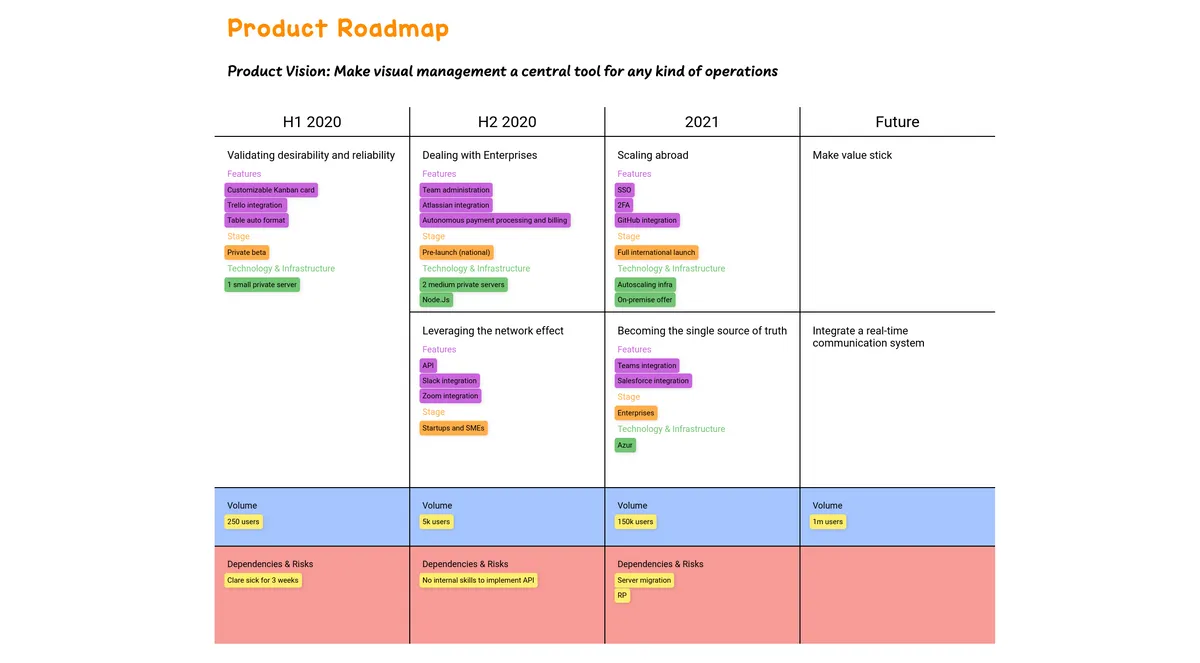What is a Product Roadmap?
According to Product Roadmaps Relaunched (and with which we are totally aligned at Draft.io): “a Product Roadmap describes how you intend to achieve your product vision. It focuses on the value you propose to deliver to your customer and your organization in order to rally support and coordinate effort among stakeholders.”
In other words, a Product Roadmap is an important tool used for strategic planning and team alignment—and a way to ensure that all stakeholders involved stay focused on solving the customer problems that a product seeks to address. Unlike more tactical artifacts, like release plans, project plans, or even Gantt Chart, a Product Roadmap is a more strategic artifact that guides the full product development process.
For all the product managers reading this, keep in mind that the Product Roadmap is not meant to be used to document release features or other tactical matters. This is all about aligning your team around a single product vision and strategy.
Therefore, building a Product Roadmap is really an opportunity to take a step back and think about the big picture. Part of this involves asking yourself the following questions:
- Why are we developing this product in the first place?
- What will be its impact on our customers, our organization, or to the planet?
Because every product is a bit different in size and scope, there is no true one-size-fits-all for building a Product Roadmap. It can take on many forms. This is heavily influenced by the human and financial resources allocated to it, the organizational processes that need to be followed to see its development through, and the impact that it will eventually have on your customers or internal stakeholders. However, for the purposes of this exercise, we will propose a simple framework that can be easily adapted to your needs or business context.
How to build a Product Roadmap?
Before starting to build a Product Roadmap, you need to gather a variety of strategic inputs to ensure that your product’s strategy is solid right from the start. This includes reviewing current market and industry trends, learning more about your target customers’ needs, refining customer personas, and conducting an audit of what your product is expected to do.
Once you have this information in place, you can begin building your Product Roadmap around these five key components:
- Product vision: The overarching strategy guiding the product development process. This is discussed in more detail below.
- Business objectives: These will be used to measure your team’s progress against organizational or product-related goals.
- Timeframes: These must be broad enough to avoid becoming too focused on artificial deadlines—that can inadvertently make teams lose sight of the product vision—but also concrete enough to ensure that progress continues to be made.
- Themes: These are intended to categorize the customer needs or problems addressed by the product in order to reach overarching business objectives.
- Disclaimer: These call out potential risks that could impact the Agile process or, in the worst case scenario, eventually derail the Product Roadmap altogether.
There are a number of optional secondary components that you can add to this list above to ensure that all product stakeholders have all the (strategic) information they need to stay aligned on the product’s overall vision. For example, adding Product Areas can provide more context around which parts of a given product will address specific business objectives. Additionally, enriching your Themes with details like high-level features and solutions, the various stages of development, information about your target customers, and even a confidence indicator can help round out and complete your Product Roadmap.

How to develop a compelling product vision
A product vision is the north star that guides all decision-making throughout the product development process. This includes decisions around which features and functionality need to be added to address a target customer’s needs or help them solve their problems.
To provide an anecdote, the basics of business strategy—including how to develop a succinct product vision—can be understood through the lens of military strategy. Reiterated by Colonel Richard Mackey in his essay, Translating Vision Into Reality: The Role of the Strategic Leader (1992), the U.S. Army War College professor explained that the key characteristics of any compelling strategic vision must:
- Create a clear mental image
- Can be clearly communicated and easily understood
- Generate genuine excitement or interest
- Drive commitment among customers and stakeholders
- Describe a desired future state
- Exist within a specific context
- Establish or reinforce a unique set of values
These are the same principles that must guide the development of your product vision. Remember, as a strategic artifact, this is the element that will ensure everyone involved in the product development process stays focused on achieving a single goal. So taking the time to get this part right can truly make all the difference in the end.
Suggested resources to go further with Product Roadmap
- Roman Pichler’s 10 tips for creating an agile product roadmap.
- John Cutler’s blog article Beyond “Outcomes over Outputs”.
- A presentation from Jason Tanner, CEO at Applied Frameworks, at Scrum Gathering called Product Roadmaps that work.
